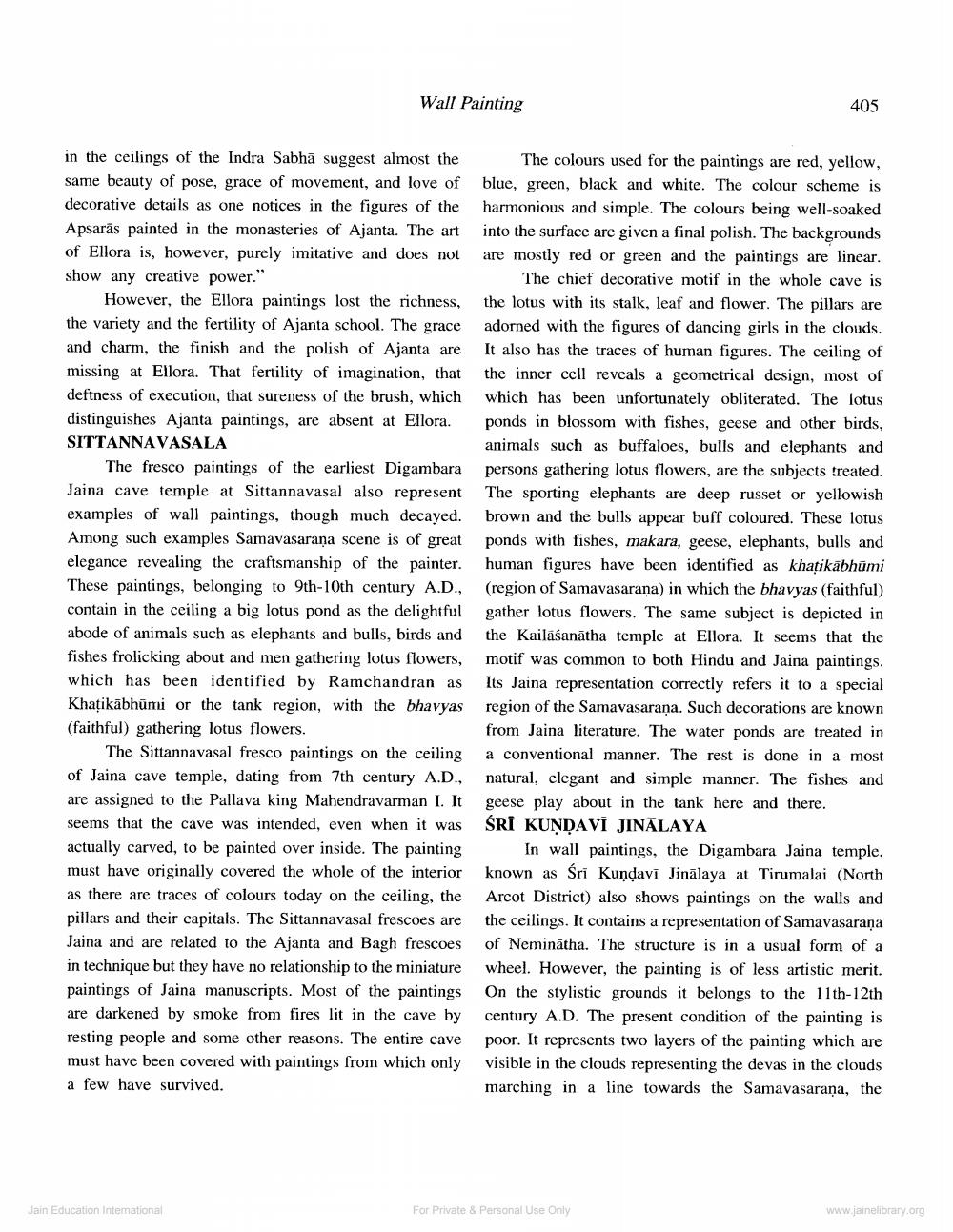________________
Wall Painting
405
in the ceilings of the Indra Sabhā suggest almost the The colours used for the paintings are red, yellow, same beauty of pose, grace of movement, and love of blue, green, black and white. The colour scheme is decorative details as one notices in the figures of the harmonious and simple. The colours being well-soaked Apsarās painted in the monasteries of Ajanta. The art into the surface are given a final polish. The backgrounds of Ellora is, however, purely imitative and does not are mostly red or green and the paintings are linear. show any creative power."
The chief decorative motif in the whole cave is However, the Ellora paintings lost the richness, the lotus with its stalk, leaf and flower. The pillars are the variety and the fertility of Ajanta school. The grace adorned with the figures of dancing girls in the clouds. and charm, the finish and the polish of Ajanta are It also has the traces of human figures. The ceiling of missing at Ellora. That fertility of imagination, that the inner cell reveals a geometrical design, most of deftness of execution, that sureness of the brush, which which has been unfortunately obliterated. The lotus distinguishes Ajanta paintings, are absent at Ellora ponds in blossom with fishes, geese and other birds, SITTANNAVASALA
animals such as buffaloes, bulls and elephants and The fresco paintings of the earliest Digambara persons gathering lotus flowers, are the subjects treated. Jaina cave temple at Sittannavasal also represent The sporting elephants are deep russet or yellowish examples of wall paintings, though much decayed. brown and the bulls appear buff coloured. These lotus Among such examples Samavasarana scene is of great ponds with fishes, makara, geese, elephants, bulls and elegance revealing the craftsmanship of the painter. human figures have been identified as khatikābhūmi These paintings, belonging to 9th-10th century A.D., (region of Samavasarana) in which the bhavyas (faithful) contain in the ceiling a big lotus pond as the delightful gather lotus flowers. The same subject is depicted in abode of animals such as elephants and bulls, birds and the Kailasanātha temple at Ellora. It seems that the fishes frolicking about and men gathering lotus flowers, motif was common to both Hindu and Jaina paintings. which has been identified by Ramchandran as Its Jaina representation correctly refers it to a special Khatikābhūmi or the tank region, with the bhavyas region of the Samavasarana. Such decorations are known (faithful) gathering lotus flowers.
from Jaina literature. The water ponds are treated in The Sittannavasal fresco paintings on the ceiling a conventional manner. The rest is done in a most of Jaina cave temple, dating from 7th century A.D., natural, elegant and simple manner. The fishes and are assigned to the Pallava king Mahendravarman I. It geese play about in the tank here and there. seems that the cave was intended, even when it was SRI KUNDAVİ JINĀLAYA actually carved, to be painted over inside. The painting In wall paintings, the Digambara Jaina temple, must have originally covered the whole of the interior known as Sri Kundavi Jinālaya at Tirumalai (North as there are traces of colours today on the ceiling, the Arcot District) also shows paintings on the walls and pillars and their capitals. The Sittannavasal frescoes are the ceilings. It contains a representation of Samavasarana Jaina and are related to the Ajanta and Bagh frescoes of Neminātha. The structure is in a usual form of a in technique but they have no relationship to the miniature wheel. However, the painting is of less artistic merit. paintings of Jaina manuscripts. Most of the paintings On the stylistic grounds it belongs to the 11th-12th are darkened by smoke from fires lit in the cave by century A.D. The present condition of the painting is resting people and some other reasons. The entire cave poor. It represents two layers of the painting which are must have been covered with paintings from which only visible in the clouds representing the devas in the clouds a few have survived.
marching in a line towards the Samavasarana, the
Jain Education Intemational
For Private & Personal Use Only
www.jainelibrary.org




